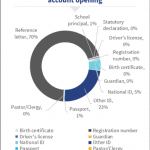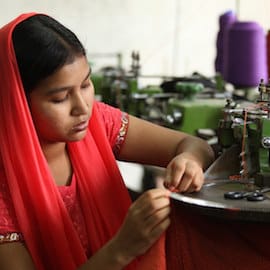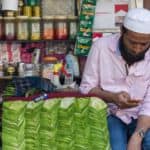Do Formal Savings Accounts Lead to Better Results for Low-Income Users?: Lessons from Two Customer-Centric Research Studies in Africa
The Savings Learning Lab was a six-year initiative that supported learning among Mastercard Foundation’s savings-focused financial inclusion programs across Africa. At the initiative’s close-out event last September, program partners Savings at the Frontier (SatF) and Scale2Save discussed two ways they researched the impact of formal savings accounts on the lives of low-income people.
Both of their client-centric research approaches went beyond access to and usage of savings accounts to understand the nuances of client preferences and behaviors. This is the kind of research needed to move the needle on savings for low-income clients. I’ll discuss these findings and their implications below.
The Qualitative Impact Assessment Protocol Research Approach
The SatF program, implemented by Oxford Policy Management, worked in partnership with 10 financial service providers (FSPs) in Ghana, Tanzania and Zambia to develop innovative financial services for informal savings mechanisms and their users. These mechanisms include a range of collective savings structures, namely: Village Savings and Loans Associations, Rotating Savings and Credit Associations, Accumulating Savings and Credit Associations, agricultural affinity groups, less-structured savings groups, and susu collection. SatF was designed as an adaptive program to support innovation and test whether and how formal FSPs can serve these informal savings mechanisms and their users.
With support from Bath Social and Development Research Ltd., SatF took a qualitative approach to understand how formal savings accounts led to changes in livelihoods from the customer’s perspective. Their study examined the outcomes of a set of savings linkage products, which connected informal savings group members to formal FSPs in the three target countries over the course of the SatF program. To reduce the risk of biases, this research approach asked these customers about changes in their lives — and what they attributed these changes to — in an open-ended way. This approach was in contrast to more narrowly focused research methods that ask about a particular product or service, which might prompt the customers and create bias in their responses.
The customers were asked about any changes in their financial practices, income-generating activities and financial well-being, and were invited to describe how and why these changes happened. SatF wanted to learn whether customers would attribute any of these changes to the savings linkage products without the researchers prompting them, or naming the products during the interviews. Listening to customers’ unfiltered thoughts about the impacts of these linkage products in a broader context helped researchers to understand the real impact of the products, and how the products led to these changes.
SatF’s research provided highly detailed feedback to FSPs on customers’ behavioral patterns. The findings were complex, and there was great variation in the ways in which customers saved — e.g., saving with M-PESA, via savings groups, etc. But one common finding was that people talked about relationships and not products. What mattered to these clients was, for example, not the technical features of a digital savings account, but rather the human contact they had with the FSP’s agents when accessing these products. This highlighted the fact that working through agents can make FSPs more approachable: Because agents are embedded in the local social and cultural networks, customers have more confidence in working with them.
The Customer Outcomes-Based Research Approach
Scale2Save, implemented by World Savings and Retail Banking Institute, worked in partnership with 12 FSPs across six countries: Kenya, Uganda, Nigeria, Côte D’Ivoire, Senegal and Morocco. The program focused on establishing the viability of low–balance savings accounts and the use of customer-centric approaches to address barriers in savings account access, usage and affordability.
Sale2Save and its partner Centenary Bank in Uganda collaborated with CGAP to test whether a customer outcomes-based approach to consumer protection could be used as a measuring tool to assess Centenary’s savings product. Specifically, the customer outcomes framework was used to assess whether the product was working as intended, if it was improving the lives of target customers, and whether (and how) Centenary was contributing to Uganda’s financial inclusion goals. This approach is designed for FSPs and regulators, as it utilizes supply-side data that these organizations are already able to track. Having previously been tested with the Financial Sector Conduct Authority, the market conduct regulator in South Africa, and five FSPs in South Africa, the approach is structured and flexible enough to accommodate various financial products in different country contexts. It utilizes a framework that includes 156 qualitative and quantitative indicators, from which a much smaller subset is then prioritized based on both the challenges and realities that consumers face in a particular market, and on the information that’s available to support these measurements.
In Scale2Save’s case, the data used came from Centenary’s basic savings account, which targets youth and women. The Bank of Uganda (BoU)’s Financial Inclusion Strategy 2017 served as the basis for assessing Centenary’s contribution to country-level financial inclusion goals. The BoU’s five strategic goals identified 20 gaps they wanted to address. These gaps were used to map the customer outcomes indicators to the Ugandan context. From there, 10 foundational indicators were selected based both on the BoU’s national financial inclusion strategy, and on which data was available to Centenary’s central analytics team.
To understand access barriers for youth (under 30), the approach evaluated whether Centenary attracts its target segments and retains these customers, both throughout their lifetime and through changes in circumstance and income. It looked at four elements: 1) which savings customers were new to the bank; 2) whether these customers were offered more sophisticated products once they hit certain benchmarks; 3) whether customers were offered loans; and 4) customers’ levels of account inactivity, as compared to the broader market.
The results, outlined in more detail in this report, Application of CGAP Customer Outcomes Framework in Uganda, helped the bank understand that they were indeed reaching this customer group, at higher rates than the market, and that they were able to grow with these customers, offering more suitable loans and products as their needs evolved. The study also showed that account inactivity was higher than the norm. This allowed the bank to hone in on this inactivity, developing solutions that would boost client satisfaction and increase the sustainability of their product.
The ultimate goals of the customer outcomes framework are to help authorities, like the Bank of Uganda, understand which strategies, policies, practices, activities, products and services work/do not work for customers; to evaluate the impact of financial services at a market level for all types of customers; and to assess if, and how, financial service providers are contributing to national financial inclusion goals. The Head of Financial Inclusion for the BoU emphasized how useful this pilot has been for them, allowing them to identify issues across banks, like product mismatch and inactivity, earlier — using information that banks already have available. As Uganda develops its new national financial inclusion strategy, the central bank believes it will be important to carry out this exercise again, and to make the case to all FSPs of its value.
You can view the recordings of the close-out learning event here: Part 1, Part 2. And for more useful resources on this topic from SatF and Scale2Save, check out the Guide to Inclusive Savings, curated by the Savings Learning Lab.
Jenny Morgan is the Impact Pathways Facilitator for FinEquity.
Photo courtesy of International Monetary Fund.
- Categories
- Finance, Impact Assessment



